Disney Princess
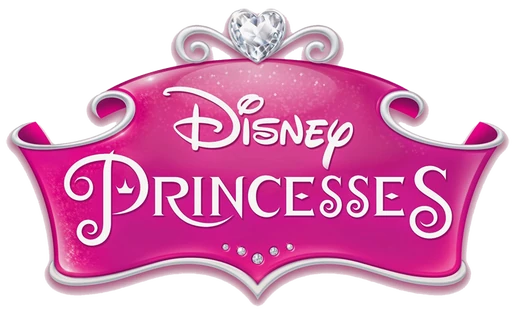 Disney Princess Original work
Disney Princess Original work
Animated films
Park attractionsMickey's Pirate and Princess Party
SourceDisney Princess is a franchise with a line-up of fictional female heroines who have appeared in various Disney animated feature films. Owned by the Walt Disney Company, and created in the mid-1990s.The franchise currently comprises of twelve female protagonists from eleven different Walt Disney Animation Studios films and one Pixar film, who are either royal by birth, royal by marriage, or considered a "princess" due to their significant portrayal of heroism in their respective films.
The character line-up has varied since the creation of the franchise. Currently, the franchise is comprised of 12 members: Snow White, Cinderella, Aurora, Ariel, Belle, Jasmine, Pocahontas, Mulan, Tiana, Rapunzel, Merida, and Moana.[1]
The Disney Princesses are featured prominently through theme parks, dolls, jewelry and apparel, video games, and crossover feature films and television shows.
From 2012 to 2021, with the exception of those created after the Disney Renaissance, the Princesses are showcased in their enhanced and modified redesigned outfits instead of the ones that they wear in their own movies. The classic looks from their movies were brought back and enhanced for the Ultimate Princess Celebration event.
HistoryIn the early 1990s, Disney Consumer Products realized the market potential for the female characters portrayed in the wildly successful Disney movies. Soon after realizing the demand, the Disney Princess franchise was launched.
In the mid-1990s the princesses began to be marketed together in the doll lines Perfume Princess, Musical Princess, and Dancing Princess.
On March 12, 1996, Walt Disney Records released the first compilation of the franchise: Princess Collection. The album went on to peak at #4 on Billboard's Top Kid Audio chart.[2]
The first issue of the Disney Princess Magazine was published on June 24, 1998 in the United Kingdom. Its slogan was "Every girl can be a Princess!". The launch of the magazine was supported by radio, press and retail promotions, including a cross-promotion with Mattel in Toys 'R' Us and with Panini stickers.[3][4]
The Princesses to be featured in the franchise were chosen from classic Disney films. The characters were not chosen specifically for their royal titles, but rather for how well they fit into what Disney executives deemed "the Princess mythology". Mulan is an example of this concept; she has no familial ties to royalty but is still included in the character list. Tinker Bell and Esmeralda were once included under the same principle before it was decided that they were not suited for the "mythology".[5][6] In 2005, though, Tinker Bell has starred in her own Disney franchise, the Disney Fairies. Other fairies were created specifically for the franchise. The line began with a book series by Gail Carson Levine and has since spawned toys, direct-to-video movies and other products based on the characters. At one point, Jane Porter, Giselle, Anna, and Elsa were considered to be included in the line-up, but weren't realized.
Character BackgroundThe characters themselves, despite appearing in separate films, have distinct similarities. The Princesses show good will towards all creatures, evidenced by the common ability to communicate with animals. The Princesses are known for their inner and outer beauty, as well as having beautiful singing voices, apart from Merida, who only sings a song with her mother when she is little in her film, Brave.
Each Princess, excluding Merida and Moana, has a romance that is resolved by the end of her debut film. These charismatic girls carry a similar personality in their eras.
At the beginning with the first three (Snow White, Cinderella, and Aurora), their characteristics were well known as classy, graceful, and romantic daydreamers, who suffered from the actions caused by others. They held an inner strength through compassion, love, kindness and, particularly with Cinderella, a strong sense of resilience, without having to demonstrate the more masculine, proactive traits of the later Princesses.
Since the Renaissance Era, these popular heroines became more active than reactive with Ariel, Belle, Jasmine, Pocahontas, and Mulan. Their characteristics were known to be much more strong-willed, adventurous, feisty, cunning, and determined. As well their goals focused more on adventure and freedom than love, and these girls were more fighters for their dreams than the first three. They also existed in worlds which were more self-aware of the traditional and changing role of women; particularly Ariel, with her villainess assuring her that women on land should keep silent, Belle, with her villain assuring her that "it's not right for a woman to read", and Mulan, with her peers extolling masculine traits in addition to those of the ideal wife. The most recent ones - Tiana, Rapunzel, Merida, and Moana - are in the modern era; Tiana, an original character, is much more a realist than the others, she does not need nor want magic to make a dream come true but with only hard work, whereas Rapunzel is much more like the idealistic ones than Tiana.
Snow White, Aurora, Ariel, Jasmine, Rapunzel, and Merida are born of royal heritage as daughters of kings and queens. Pocahontas can be considered as being of royal heritage, as she is the daughter of a chief and considered Native American royalty by the English, as well as being called a princess in her film's sequel. Cinderella, Belle, and Tiana become royalty by marriage. Mulan was neither royal by birth or marriage, but is still included in the line-up due to her high status by saving China and receiving grace from the Emperor. Moana, herself, states that she is not a princess, but as daughter to a chief, the roles are similar. And just like Mulan, she received grace from Te Fiti for saving the world from destruction.
In the 2016 film Moana, Maui states that princesses have animal sidekicks. This has been evidently shown to be a common characteristic among the official members.
Members Official members 1. Snow White 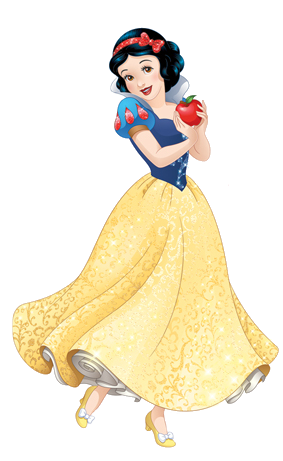 Snow White Live-Action Reference Model Source The character of Snow White first originated in 1937 from a Brothers Grimm fairy tale "Schneewittchen" about a beautiful German princess with a jealous stepmother. Walt Disney turned this classic fairy tale into his very first animated feature film. Her true love is the Prince, who breaks her sleeping death 'slumber' (caused by the Evil Queen) with love's first kiss. She befriends the seven dwarfs during her stay at their cottage. At age 14, she is the youngest of the Princesses.
Snow White Live-Action Reference Model Source The character of Snow White first originated in 1937 from a Brothers Grimm fairy tale "Schneewittchen" about a beautiful German princess with a jealous stepmother. Walt Disney turned this classic fairy tale into his very first animated feature film. Her true love is the Prince, who breaks her sleeping death 'slumber' (caused by the Evil Queen) with love's first kiss. She befriends the seven dwarfs during her stay at their cottage. At age 14, she is the youngest of the Princesses.
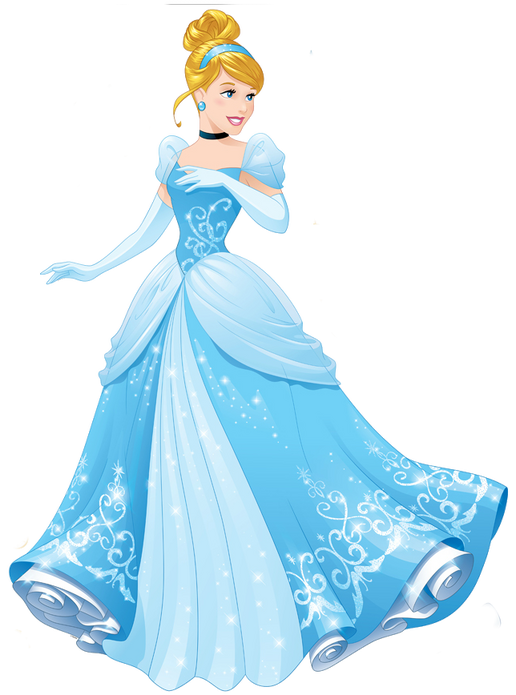 Cinderella Live-Action Reference Model
Cinderella Live-Action Reference Model
Helene Stanley
Source Based on the most known version of Cinderella stories, "Cendrillon" by Charles Perrault in 1697. In 1950, it was turned into an animated feature-length film by Walt Disney. Cinderella is the eldest of all the Disney Princesses. Her stepmother turned her into the family's sole servant after the death of her father. With magical help from her Fairy Godmother, she attends a royal ball and meets Prince Charming, and eventually marries him, thus freeing herself from her life of servitude. In the two sequels; "Dreams Come True" and "A Twist In Time", Cinderella also manages to repair her relationship with her younger stepsister Anastasia and help her find true love. Cinderella is often considered the leader of the Princesses; often being put in the center of the group shots, and having also been deemed Walt Disney's personal favorite heroine. 3. Aurora 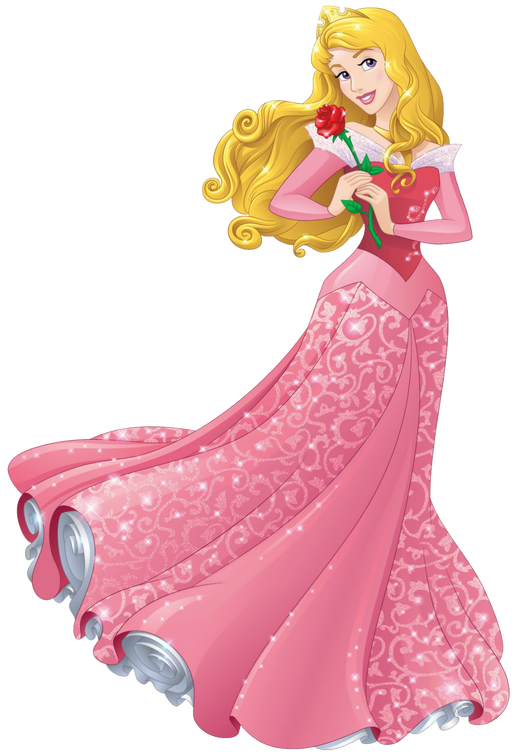 Aurora Live-Action Reference Model
Aurora Live-Action Reference Model
Helene Stanley
Source Best known as the heroine of the 1959 animated classic Sleeping Beauty, which is based on Charles Perrault's "La Belle au Bois Dormant". Although her dress changes from blue to pink thanks to a disagreement between two of her guardians, Merryweather and Flora, outside the film, she is most commonly seen wearing pink. She was cursed at birth to die before the sun sets on her 16th birthday by the evil fairy Maleficent by pricking her finger on the spindle of a spinning wheel. One of the three good fairies, Merryweather, was able to weaken the curse by changing death to a deep slumber that could only be awakened by true love's kiss. By falling in love with Prince Phillip, the prince of a neighboring kingdom (and unknown to either of them, her betrothed), she was freed from the curse. Aurora is shown to be one of the taller princesses in the franchise. 4. Ariel 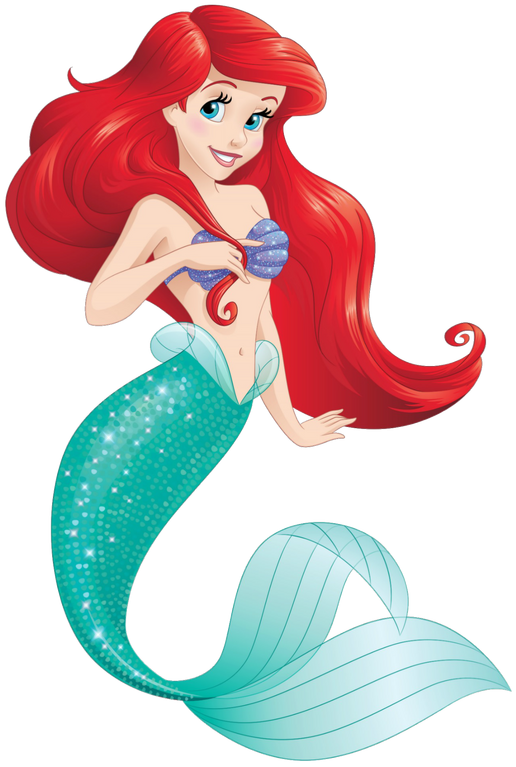 Ariel Live-Action Reference Model Source
Ariel Live-Action Reference Model Source
The heroine of the 1989 film, based on the Danish fairy tale "Den Lille Havfrue" by Hans Christian Andersen, and the daughter of King Triton, ruler of the sea. Ariel is a 16-year-old mermaid who falls in love with a dashing human Prince Eric, an extension of her fascination with all things from the surface world. Her dream is to live a life on land. So it comes as no surprise when her dream causes her to fall victim to accepting a shady offer from Ursula the Sea Witch promising her a lifetime of happiness with Prince Eric as long as she carries out the rules outlined in the signed, binding contract. Ursula persuades her to trade her beautiful voice, in exchange for becoming a human for three days. During these three days, Ariel must not only make Prince Eric fall in love with her, but the two must seal their love with a kiss. If Ariel is unable to uphold her end of the agreement, she must return to the sea to live out her days in Ursula's lair as a prisoner, joining the many other "lost souls" that have fallen victim to Ursula's "wish granting" over the years. However, Ariel is able to defeat Ursula with Eric's help and thanks to her father, she becomes human permanently and marries Eric at the end of the film.
Hans Christian Andersen's original character dissolves into foam on the sea after the prince marries someone else, but through an act of compassion is transformed into a spirit of the air. Co-director Ron Clements felt the story was too tragic, and changed the original character from the tragic but hopeful heroine to the brave and resourceful Ariel. 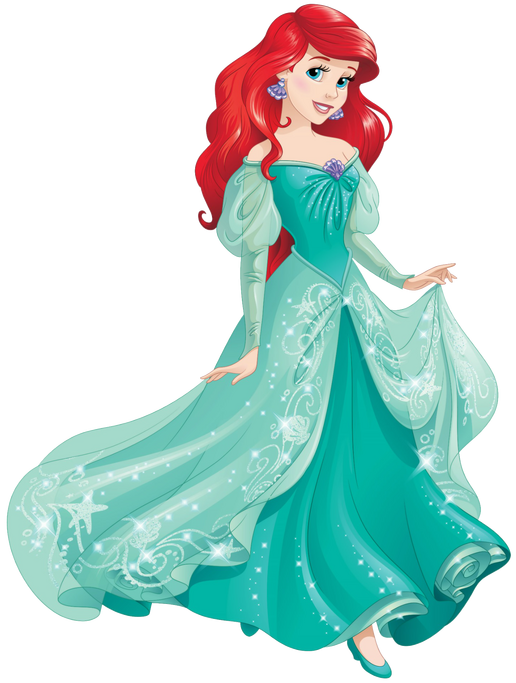 Ariel Live-Action Reference Model Source
Ariel Live-Action Reference Model Source
The heroine of the 1989 film, based on the Danish fairy tale "Den Lille Havfrue" by Hans Christian Andersen, and the daughter of King Triton, ruler of the sea. Ariel is a 16-year-old mermaid who falls in love with a dashing human Prince Eric, an extension of her fascination with all things from the surface world. Her dream is to live a life on land. So it comes as no surprise when her dream causes her to fall victim to accepting a shady offer from Ursula the Sea Witch promising her a lifetime of happiness with Prince Eric as long as she carries out the rules outlined in the signed, binding contract. Ursula persuades her to trade her beautiful voice, in exchange for becoming a human for three days. During these three days, Ariel must not only make Prince Eric fall in love with her, but the two must seal their love with a kiss. If Ariel is unable to uphold her end of the agreement, she must return to the sea to live out her days in Ursula's lair as a prisoner, joining the many other "lost souls" that have fallen victim to Ursula's "wish granting" over the years. However, Ariel is able to defeat Ursula with Eric's help and thanks to her father, she becomes human permanently and marries Eric at the end of the film.
Hans Christian Andersen's original character dissolves into foam on the sea after the prince marries someone else, but through an act of compassion is transformed into a spirit of the air. Co-director Ron Clements felt the story was too tragic, and changed the original character from the tragic but hopeful heroine to the brave and resourceful Ariel. 5. Belle 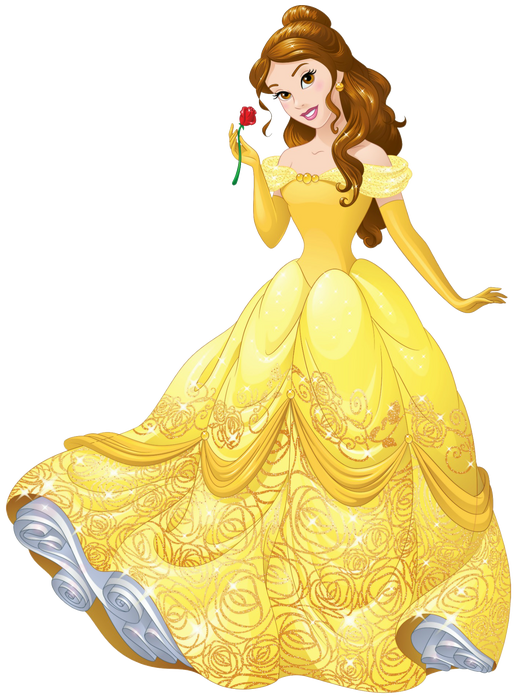 Belle Live-Action Reference Model Source The French commoner who is the heroine of the 1991 animated classic Beauty and the Beast, is based on the French fairy tale "La Belle et la Bête" by Gabrielle-Suzanne de Villeneuve which was abridged by Jeanne-Marie Leprince de Beaumont. The name Belle translates from the French word for "beauty". In the film, she selflessly trades in her freedom, for that of her father's, in a bargain with the Beast, thus becoming his prisoner/guest. She soon learns to see the good hidden behind his hideous appearance and rough manner and eventually, over time, falling in love with him. By confessing her love at the end of the movie, she breaks the curse placed on him by the enchantress. The Beast and his staff are then restored to their human forms, and Belle became his princess.
Belle Live-Action Reference Model Source The French commoner who is the heroine of the 1991 animated classic Beauty and the Beast, is based on the French fairy tale "La Belle et la Bête" by Gabrielle-Suzanne de Villeneuve which was abridged by Jeanne-Marie Leprince de Beaumont. The name Belle translates from the French word for "beauty". In the film, she selflessly trades in her freedom, for that of her father's, in a bargain with the Beast, thus becoming his prisoner/guest. She soon learns to see the good hidden behind his hideous appearance and rough manner and eventually, over time, falling in love with him. By confessing her love at the end of the movie, she breaks the curse placed on him by the enchantress. The Beast and his staff are then restored to their human forms, and Belle became his princess.
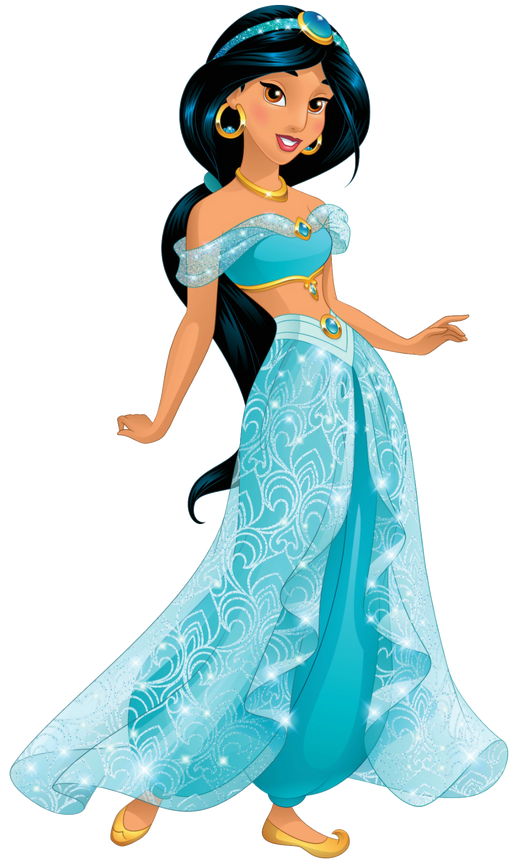 Jasmine Live-Action Reference Model
Jasmine Live-Action Reference Model
Robina Ritchie
Source The spunky, independent Arabian Princess of Agrabah, who dreams of seeing what's beyond her palace and be freed from her father's constant pestering of arranged royal marriage. She falls in love with Aladdin, a street rat, and falls in love with him again after he makes a wish from a Genie to become a prince. Though Jasmine did not recognize Aladdin in his prince disguise, she fell in love due to him seeing her as a person and for him having a good heart. After Aladdin reveals his true identity and saves Jasmine and her kingdom from Jafar, Jasmine's father removes the royal law so Jasmine can be with Aladdin, whom she eventually marries.She is based on Princess Badroulbadour (Arabic بدر البدور, badru l-budūr, "full moon of full moons") featured in the story of "Aladdin and his Wonderful Lamp" from "One Thousand and One Nights" of Scheherazade. Interestingly, the original story took place in China and not the Middle East.
7. Pocahontas 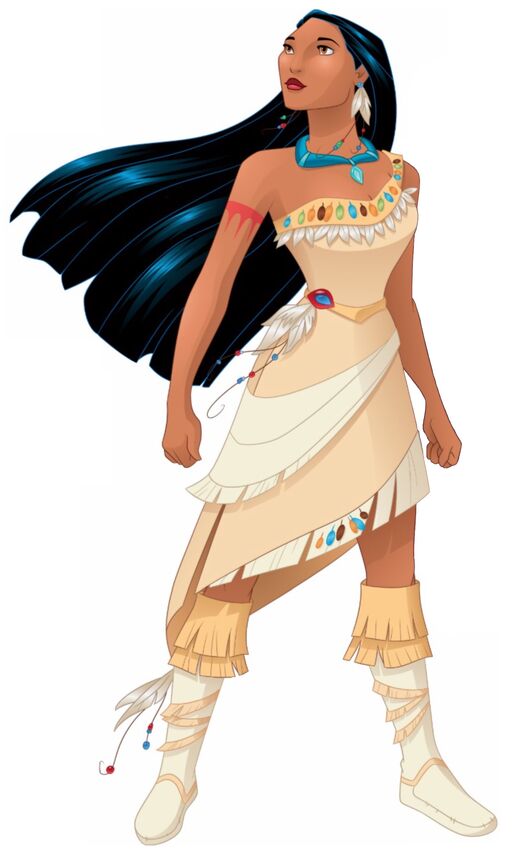 Pocahontas Source Disney's Pocahontas is based on the real life Native American "princess" of the Powhatan tribe (a name also borne by her father, the chief). Her real name was Matoaka since Pocahontas was her nickname and meant 'Playful One'. She is a free spirit, which she gets from her deceased mother. Pocahontas wants to choose her own path and doesn't want to marry her father's choice for a husband, Kocoum. Once the English settlers arrive, she teaches a man named John Smith about nature and her culture. The two later fall in love. Once John is taken prisoner, Pocahontas helps prevent a war from commencing between their people. At the end of the film, John is wounded and sent back to London for treatment, where Pocahontas remains in her village to look after her people. She is the first woman of color to be the protagonist of her respective film, along with being voiced by an actor of the same ethnicity. She is also the first princess to choose her people over the lover in the end of her feature film.
Pocahontas Source Disney's Pocahontas is based on the real life Native American "princess" of the Powhatan tribe (a name also borne by her father, the chief). Her real name was Matoaka since Pocahontas was her nickname and meant 'Playful One'. She is a free spirit, which she gets from her deceased mother. Pocahontas wants to choose her own path and doesn't want to marry her father's choice for a husband, Kocoum. Once the English settlers arrive, she teaches a man named John Smith about nature and her culture. The two later fall in love. Once John is taken prisoner, Pocahontas helps prevent a war from commencing between their people. At the end of the film, John is wounded and sent back to London for treatment, where Pocahontas remains in her village to look after her people. She is the first woman of color to be the protagonist of her respective film, along with being voiced by an actor of the same ethnicity. She is also the first princess to choose her people over the lover in the end of her feature film.
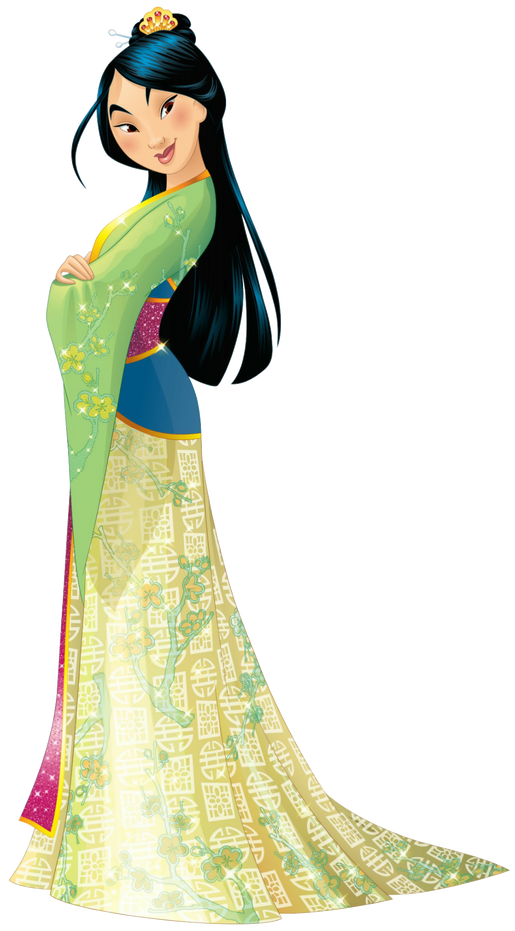 Mulan Source Fa Mulan (or simply Mulan) is a brave heroine who impersonates a male soldier to fight for the Chinese Imperial Army in order to protect her ailing father who would have been required to go if she had not gone in his place. Mulan pretends to be her father's son, Ping, risking death, and dishonor if she is discovered. Joining a struggling troop of rookies led by Captain Li Shang (or simply Shang), "Ping" is the driving force behind the troop's dramatic change into respectable soldiers. "Ping" is admired by everyone until "he" is injured during the battle and requires medical care, resulting in the outing of "his" secret. Since "Ping" had saved Shang's life, Shang repays his debt and spares Mulan's life. No longer allowed in the Imperial Army, Mulan goes rogue and defeats the leader of the Hun army, Shan Yu. The Chinese Emperor praises Mulan, recognizing her as a hero for saving China and for bringing honor to her family. Mulan is welcomed back into her home with loving, open arms. Shang arrives at Mulan's home shortly after her return, and the two's feelings for each other are made known.
Mulan Source Fa Mulan (or simply Mulan) is a brave heroine who impersonates a male soldier to fight for the Chinese Imperial Army in order to protect her ailing father who would have been required to go if she had not gone in his place. Mulan pretends to be her father's son, Ping, risking death, and dishonor if she is discovered. Joining a struggling troop of rookies led by Captain Li Shang (or simply Shang), "Ping" is the driving force behind the troop's dramatic change into respectable soldiers. "Ping" is admired by everyone until "he" is injured during the battle and requires medical care, resulting in the outing of "his" secret. Since "Ping" had saved Shang's life, Shang repays his debt and spares Mulan's life. No longer allowed in the Imperial Army, Mulan goes rogue and defeats the leader of the Hun army, Shan Yu. The Chinese Emperor praises Mulan, recognizing her as a hero for saving China and for bringing honor to her family. Mulan is welcomed back into her home with loving, open arms. Shang arrives at Mulan's home shortly after her return, and the two's feelings for each other are made known.
The character of Mulan is based on the heroine from the well-known ancient Chinese poem "The Ballad of Mulan" (木蘭詩). She is the only Disney Princess who is not royal by blood or marriage. However, she has been bestowed the honor of a being an official Disney Princess because of her popularity as well as what she represents. The film is praised for its cultural authenticity and prevailing messages including family, love, courage, and most notably, the empowerment and equal rights of women.
9. Tiana 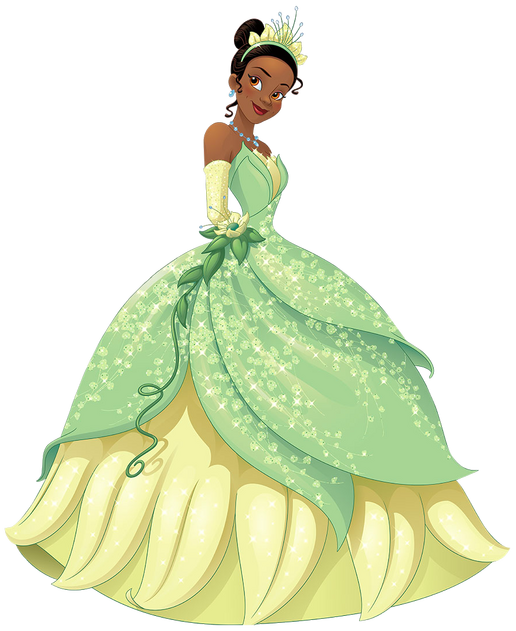 Tiana Live-Action Reference Model
Tiana Live-Action Reference Model
Danielle Moné Truitt
Source Inspired on the princess from the novel "The Frog Princess" by E.D Baker which in turn inspired by a fairy tale "The Frog Prince" by the Brothers Grimm, Tiana is the heroine of the 2009 animated film The Princess and the Frog, and is the first African-American princess. She dreams of opening her own restaurant through hard work. By kissing Prince Naveen in frog form, she is turned into a frog because she kissed him for material gain, not love, and the magic can only be broken by a princess, so they are forced to set on a journey to find a way to undo the magic. Eventually, she finds herself falling for the handsome but spoiled prince who manages to change his ways, and willingly gives up her desires wants to be with him. By marrying the prince, Tiana becomes a real princess, and with her love, breaks the spell with a kiss. They finally open their own restaurant at the end of the film.Tiana officially became a member of the Disney Princess line-up on March 14, 2010, at the New York Palace Hotel in Manhattan, New York City.
10. Rapunzel 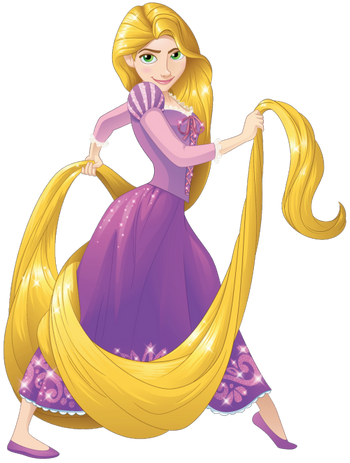 Rapunzel Source The heroine from the animated feature Tangled is based on the German title character from the Brothers Grimm fairy tale "Rapunzel". Her long hair, which is said to measure 70 feet (21 metres) in length, not only has magical healing powers but can be used as a weapon. Given the power by a magic golden flower, Mother Gothel kidnaps her as an infant to use her power to keep herself young. 18 years later, Rapunzel sneaks away from her tower with a thief, Flynn Rider, and sets on her own journey to find the flying lanterns that float into the sky every year on her birthday. Along the journey, Rapunzel falls in love with Flynn who starts revealing the caring individual he is behind his roguish personality while slowly discovering her true identity as a princess. To free her from Gothel's clutches, Flynn cuts her hair, thus destroying her power, and she is returned to her family before she eventually marries Flynn. Rapunzel was "officially welcomed into the Disney Princess Royal Court" during a promotional event at Kensington Palace in London on October 2, 2011.
Rapunzel Source The heroine from the animated feature Tangled is based on the German title character from the Brothers Grimm fairy tale "Rapunzel". Her long hair, which is said to measure 70 feet (21 metres) in length, not only has magical healing powers but can be used as a weapon. Given the power by a magic golden flower, Mother Gothel kidnaps her as an infant to use her power to keep herself young. 18 years later, Rapunzel sneaks away from her tower with a thief, Flynn Rider, and sets on her own journey to find the flying lanterns that float into the sky every year on her birthday. Along the journey, Rapunzel falls in love with Flynn who starts revealing the caring individual he is behind his roguish personality while slowly discovering her true identity as a princess. To free her from Gothel's clutches, Flynn cuts her hair, thus destroying her power, and she is returned to her family before she eventually marries Flynn. Rapunzel was "officially welcomed into the Disney Princess Royal Court" during a promotional event at Kensington Palace in London on October 2, 2011.
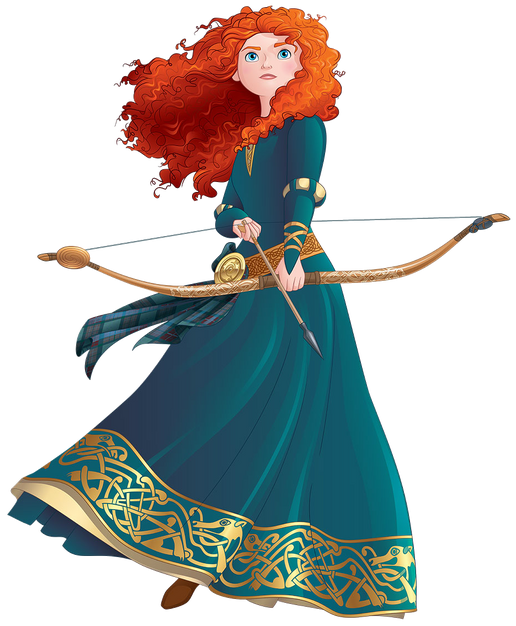 Merida Source Merida is the 16-year-old daughter of Queen Elinor, who rules the kingdom alongside her husband, King Fergus. Queen Elinor's expectations and demands of her daughter make Merida see Elinor as being cold, unfeeling, and distant, causing friction between the two. Despite Elinor's desire to see Merida as a proper royal lady, Merida is an impetuous girl with wild, unruly ginger hair and a passionate desire to take control of her own destiny. Merida has honed her skill with the bow and is the most skilled archers in her kingdom. She is also well-trained in sword-fighting and an expert horsewoman, riding wildly across the countryside on her horse, Angus.
Merida Source Merida is the 16-year-old daughter of Queen Elinor, who rules the kingdom alongside her husband, King Fergus. Queen Elinor's expectations and demands of her daughter make Merida see Elinor as being cold, unfeeling, and distant, causing friction between the two. Despite Elinor's desire to see Merida as a proper royal lady, Merida is an impetuous girl with wild, unruly ginger hair and a passionate desire to take control of her own destiny. Merida has honed her skill with the bow and is the most skilled archers in her kingdom. She is also well-trained in sword-fighting and an expert horsewoman, riding wildly across the countryside on her horse, Angus.
When Merida comes of age to have her hand in marriage, Merida becomes determined to not be forced into marriage, where her actions nearly cause a war between the kingdom and the three clans. After a heated argument with her mother, Merida visits a witch who grants her a spell to change her fate. Merida uses the spell on Elinor in an attempt to make her change her mind about the marriage, only to turn Elinor into a bear. As the two work together in finding a way to break the curse, they manage to rekindle their bond and Merida manages to resolve peace between her kingdom and the clans without being forced into marriage. After preventing a war and the defeat of the demon bear Mor'du, Merida breaks the spell by reconciling with her mother, who becomes human again and the two remain closer than ever before.
She is the first princess from a Pixar film, the first original princess in the line-up that is not inspired by either literature (Snow White, Cinderella, etc.) or real life (Pocahontas, Mulan) works, and the first without a love interest. She also never sings a major song, thus breaking away the traditional line-up, though as a child, she sang a small verse of a song in Gaelic with her mother, and Merida's rich Scottish brogue makes her the second Disney Princess with an accent other than Standard American or British. Merida officially joined the Disney Princess court on May 11, 2013, at Walt Disney World's Cinderella Castle.
12. Moana 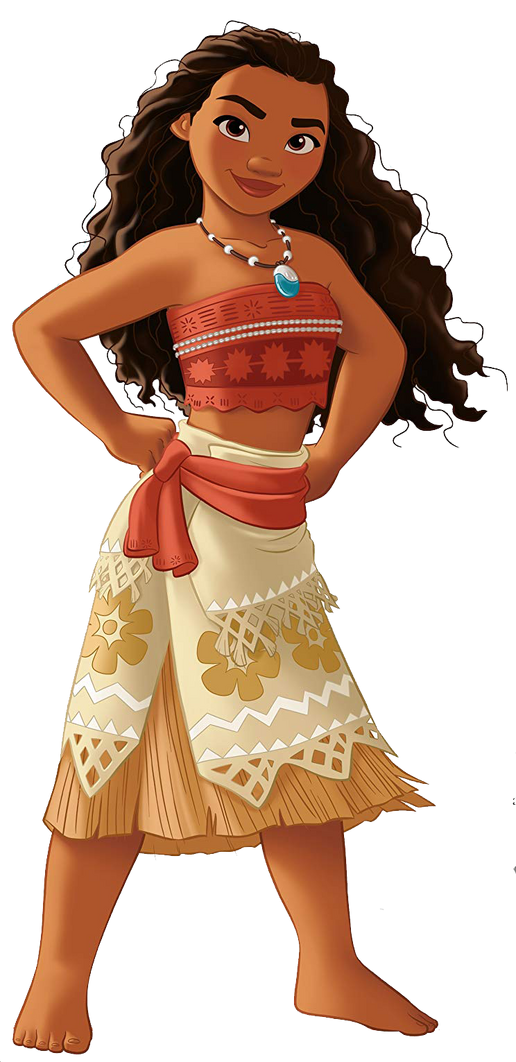 Moana Source The daughter of Motunui's village chief, Moana was chosen by the Ocean to restore the Heart of Te Fiti and save her island from a life-killing darkness. Due to an ancient law upheld by her father, Chief Tui, Moana is forbidden from ever going beyond the reef. She eventually finds the courage to do so, with the help of a powerful demigod named Maui, and the guidance of her Gramma Tala. In restoring Te Fiti's lost heart, the world is freed of darkness, allowing Moana's people to voyage the seas as freely as they please.
Moana Source The daughter of Motunui's village chief, Moana was chosen by the Ocean to restore the Heart of Te Fiti and save her island from a life-killing darkness. Due to an ancient law upheld by her father, Chief Tui, Moana is forbidden from ever going beyond the reef. She eventually finds the courage to do so, with the help of a powerful demigod named Maui, and the guidance of her Gramma Tala. In restoring Te Fiti's lost heart, the world is freed of darkness, allowing Moana's people to voyage the seas as freely as they please.
The fourth Princess to come from the minds of John Musker and Ron Clements (Ariel, Jasmine, and Tiana), Moana is one of the few Disney Princesses not to be based on a preexisting character. Rather, her story—save for real-world ties to South Pacific mythology—is almost wholly original. Furthermore, unlike her most recent predecessors, Moana was not inducted with a coronation event. Instead, she was slowly integrated via Disney Princess marketing such as books, social media posts, and toylines following the release of her film, before being added as a member to the franchise's official website in 2019.
Unofficial PrincessesDisney heroines and actual princesses that are not part of the official line-up. Several of them have appeared in some official Disney Princess products or promotions or guest starred alongside the princesses above.
Sub-franchises Royal ToddlersThis line features the Disney Princesses reimagined as young children.
Palace PetsIn July 2013, the Princesses received a spin-off franchise called Palace Pets. Currently, 10 of the 12 Princesses have more than two Palace Pets.
Thistleblossom (Snow White)
Other media Kingdom Hearts seriesIn the games, five of the official princesses are part of the Seven Princesses of Heart (セブンプリンセス Sebun Purinsesu), a group of maidens with hearts of pure Light, devoid of Darkness, and were created when the X-blade was split into seven pieces of light and thirteen of darkness. They are referred to this name because they allow access to the Door to Darkness when gathered together, and whoever gathers them will gain the power to rule over the worlds. The members in this incarnation are:
Notably, two other Disney Princesses, Ariel and Mulan, appear as well but are not Princesses of Heart. Instead, they serve as party members that fight alongside Sora in their journey to save the worlds.
In Kingdom Hearts 3D: Dream Drop Distance, it was revealed that another generation of the Princesses of Heart exists, and is elaborated upon in Kingdom Hearts III. Referred to as the "New Seven Hearts of Light", these pure-hearted maidens consist of the more recent members from the Disney Princess franchise.[22] Each inherit the title from previous members who no longer have need for the position once they willingly accept light over darkness. Kairi is the only member from the original group that is part of the new seven lights. Rapunzel, Anna, and Elsa are potential candidates; unfortunately, they become targets to Organization XIII as part of their fall-back plan in case the seven guardians of light cannot congregate. Pocahontas, Tiana, Merida, and Moana are the only ones who haven't appeared in the Kingdom Hearts series yet.
Kilala Princess seriesIn the manga series, six of the official Princesses appear, each having the power to bring peace to the world. After her best friend Erica is kidnapped, Kilala uses the power of the Magic Tiara to open the Gate of Dreams in order to find her, interacting with each of the Princesses and receiving a gem from each of them to power the Tiara during this time. Using the six gems she'd collected, Kilala manages to free the citizens of Paradiso from Valdou's control - gaining the final gem when she accepts that she is the seventh Princess and chooses to become one in her own way. The seven Princesses appear as follows:
Ralph Breaks the InternetIn the 2018 Walt Disney Animation Studios film, digital versions of the princesses (described as "netizens") appear as residents of the Internet. Vanellope von Schweetz encounters the group during her visit to Oh My Disney; in during which, Vanellope reveals herself to be the princess of Sugar Rush and is subsequently inducted into the line-up. Not including Vanellope, the fourteen official members of the court are designated as:
A toy line based on the princesses as they appear in Ralph Breaks the Internet was launched following the film's release. Dubbed "Comfy Squad" or "Comfy Princesses", the sub-franchise includes merchandise depicting the princesses in their casual clothes from the movie. Vanellope acts as the line's mascot.[23][24] Since they're not official members of the franchise, Anna and Elsa are only occasionally featured in the line.
Mickey's Pirate and Princess PartyBeginning on January 22, 2007, the Magic Kingdom at Walt Disney World hosted their newest hard ticket (separate admission) event, "Disney's Pirate and Princess Party", renamed "Mickey's Pirate and Princess Party" in 2008. The event combines the "Pirates of the Caribbean" attraction and movie series and the Disney Princess line, and cosplaying as both pirates and royalty is encouraged. Visitors can have meet and greets with characters from both franchises, and the other classic characters dressed as buccaneers and royals, and take part in various activities. Other features include the "Disney's Enchanted Adventures Parade" and the "Magic, Music and Mayhem" fireworks spectacular. Because the event has become so popular, Pirate and Princess events have become an annual hard-ticket staple with dates into August and September of 2007 and January through June of 2008.
Gallery Trivia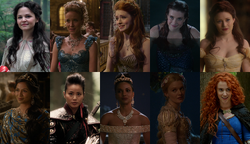

The 10 official Disney Princesses as portrayed in Once Upon a Time.


Comentarios
Publicar un comentario